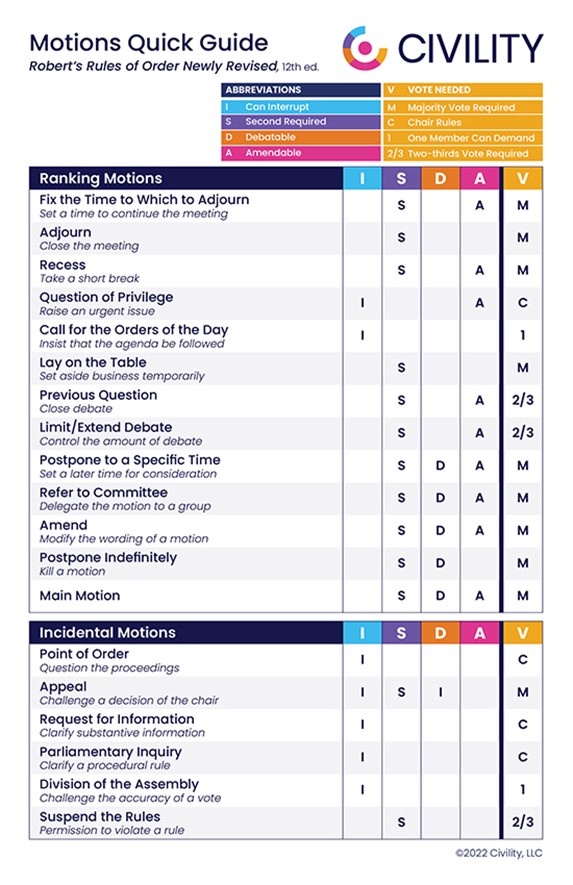It’s one thing to make a motion during a meeting—but what if more than one motion gets proposed? How do motions work with one another? Which motion should be dealt with first?
A Few Preliminaries
First, there is an official name for this concept: It’s called Order of Precedence. (Bonus info—parliamentary procedure pronounces that P word pruh-SEE-dents, not PREH-suh-dents.)
Also, a disclaimer: Order of precedence is an incredibly foundational idea within parliamentary procedure, but you should brace yourself for a little complexity. This post (and next week’s follow-up) will work to give you some clarity and help for handling all possible motions following the order of precedence. However, it is an area where things can get complicated.
And finally, here’s a reference point to keep you sane: Our recently produced Motions Quick Guide is the tool you need. It’s a downloadable, printable PDF that can help you address motions in proper order.
A Bit of Review
Let’s make sure we’re all on the same page regarding motions in general.
- In the field of parliamentary procedure, a motion is a proposal that an organization, board, or committee take a specific action.
- The process of motion-making during a meeting involves six steps. (Download Civility’s infographic resource The Lifecycle of a Motion for a quick visual guide to these steps.)
There are two basic types of motions.
- Main motions propose substantive action. They include nearly any proposals related to the objectives of a group. Also, main motions are ranked—they appear at the bottom of the list of ranking motions—see below.
- Secondary motions propose procedural action. They relate to the operation of a group’s meetings. And some secondary motions are ranked, but some are incidental/non-ranked.
So, this post addresses how you should handle all ranking secondary motions proposed while a main motion is in process.
Point 1: Ranking motions must be considered in order.
There is a priority order—an order of precedence—for consideration of ranking motions during a meeting. The following list of ranking motions includes secondary motions that are ranked and includes main motion at the bottom. Ranking motions are ranked in the following order:
- Fix the Time to Which to Adjourn
- Adjourn
- Recess
- Question of Privilege
- Call for the Orders of the Day
- Lay on the Table
- Previous Question
- Limit or Extend Debate
- Postpone to a Specific Time
- Refer to Committee
- Amend
- Postpone indefinitely
- Main Motion
Point 2: Non-ranking secondary motions have no rank or “handling order.”
Other motions—non-ranking motions—can be handled whenever they’re relevant. There’s no order of precedence with the following motions:
- Point of Order
- Appeal
- Request for Information
- Parliamentary Inquiry
- Division of the Assembly
- Suspend the Rules
Ready for a Freebie?
The Motions Quick Guide—available as a free PDF download on the resources page—is critical to have in front of you during a meeting where members may make any of the above kinds of motions.
Beyond the list of motions in ranking order, this guide includes other important details about each motion: whether it can be interrupted, whether a second is needed, whether it’s debatable, whether it’s amendable, and what type of vote is required. Users say it’s an invaluable tool to have on hand.
And There’s More Coming Soon…
Yes, this is a “Part 1” post. Look for Part 2 next week—with more how-to’s for handling motions in proper order, plus a helpful visual for understanding this important concept.
Where to Learn More


